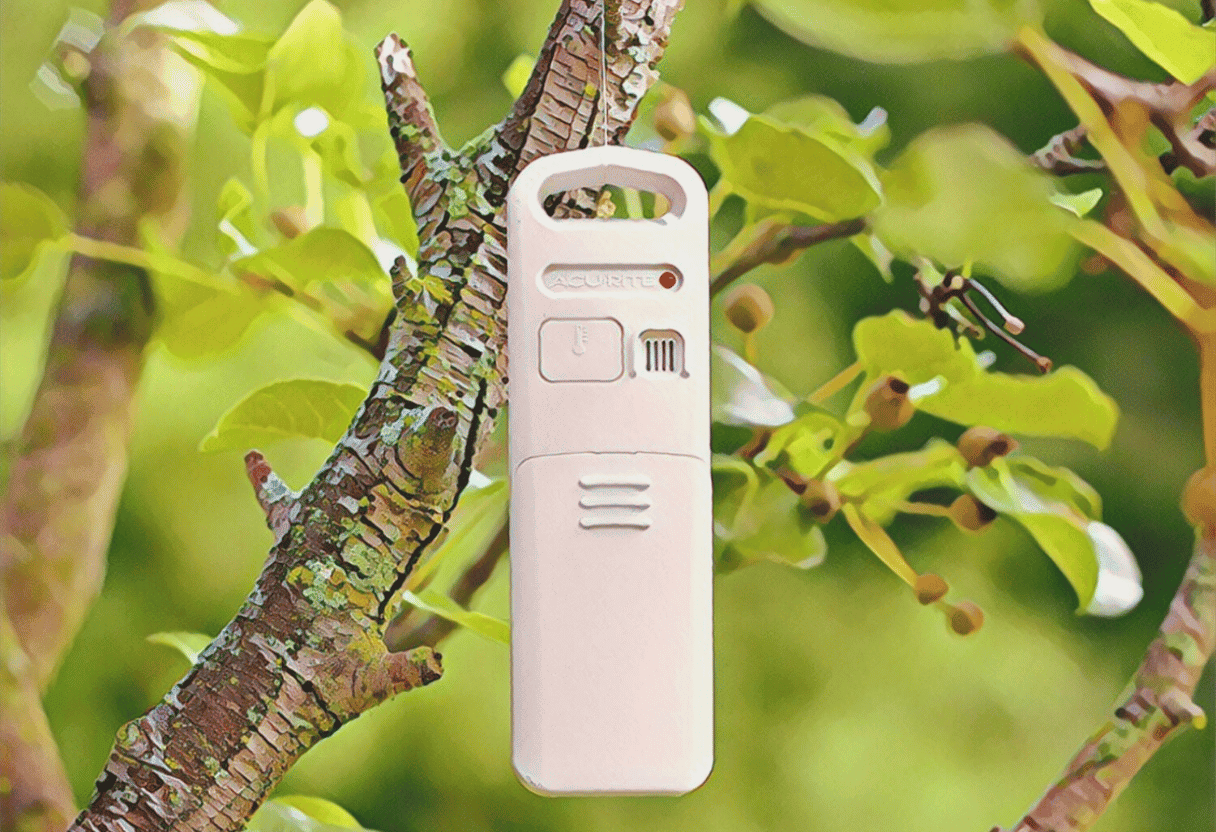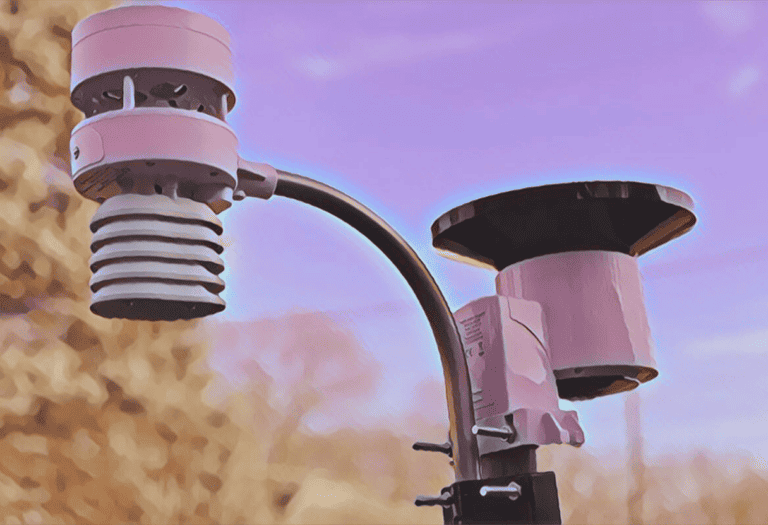Are you on the hunt for a reliable tool to keep track of the climate both inside and outside your home?
The AcuRite Wireless Indoor Outdoor Temperature and Humidity Sensor might just be the gadget you need. This sensor, compatible with various AcuRite indoor digital weather stations, offers a seamless way to monitor environmental conditions, enhancing your home weather station setup.
Well, we’ll be going over:
- What sets the AcuRite Sensor apart from other temperature and humidity trackers?
- How does its compatibility with AcuRite digital stations and AcuRite Access enhance your weather monitoring experience?
- Considering its performance and ease of use, is the AcuRite Sensor a worthy addition to your home weather station?
With the AcuRite Sensor, staying informed about the weather conditions around you has never been easier.
Let’s dive in.
Quick Review
In my experience, the AcuRite Sensor is a solid performer if you’re looking to keep tabs on weather conditions from the comfort of your own tech ecosystem. Its precise temperature and humidity readings have been a help in my daily routines. The ease of installation and connectivity features impressed me the most.
If you’re considering enhancing your environmental awareness at home, Click here to purchase the AcuRite Sensor and get real-time data updates that could make a difference in your day-to-day life.
AcuRite Wireless Temperature and Humidity Sensor Overview
From my experience with the AcuRite sensor, it’s clear that keeping an eye on weather conditions has never been more straightforward. When I set up this sensor, pairing it with my existing digital weather station was intuitively simple, and it began transmitting data right away. It’s reassuring to know I can check the current temperature and humidity from my smartphone, as it’s compatible with the AcuRite Access.
Although the sensor’s aesthetics are nearly identical to other models, ensuring compatibility before purchase is crucial, as it doesn’t work with all AcuRite products. The wireless reach is quite impressive, and I found the 16-second data transmission to be quite responsive.
What I found particularly handy was the integrated hole for easy mounting—no tools needed, just a nail and you’re set. Remember, it requires 2 AA batteries, which aren’t included, but once in place, maintenance is minimal.
A minor limitation is the need to verify compatibility with specific AcuRite models, but if it’s a match for your device, it’s a seamless fit. In terms of longevity, one of the reviews mentioned that their previous unit lasted seven years, which is a decent lifespan for outdoor gadgets. Overall, the simplicity and effectiveness of the AcuRite sensor advocates for its place in a home weather monitoring setup.
Key Features
I’ve spent some time getting to grips with the AcuRite Sensor, and it’s quite an impressive little device. Its simplicity belies its utility. Below, I’ll break down what stands out about this product, both positively and some points that may leave you desiring a bit more.
Versatile Compatibility
The sensor claims compatibility with specific AcuRite models, such as the 06002M, 592TXR, and 00592TXR. It’s handy to know it’s tailored to work seamlessly with certain weather stations and the AcuRite Access hub. However, it’s paramount to ensure your existing equipment is compatible before making the purchase to avoid the hassle of returns. The twin nature of the unit with another sensor requires a close look to distinguish the two and pick the right replacement.
Extended Wireless Range
The extended wireless range of up to 330 feet (100 meters) is quite impressive. I didn’t encounter any difficulties with signal drop-off while testing it across my property. The 433 MHz wireless signal is strong and consistent, maintaining a stable connection to the base unit beyond physical obstructions like walls and furniture. Nevertheless, it’s worth noting this range is under ideal conditions, and interference from other devices could potentially reduce it.
Frequent Data Transmission
At a glance, the unit’s data transmission every 16 seconds is fast. This regular update interval ensures near real-time tracking of temperature and humidity changes. It’s refreshing to see such swift responsiveness in a consumer-grade sensor like this one, giving users the confidence that they’re receiving up-to-date information on their environment.
Battery Powered for Convenience
Being battery-powered adds a layer of convenience since there’s no need to manage wires or stay close to power outlets. The unit requires two AA batteries, which aren’t included, so that’s an additional purchase you’ll have to consider. Whether you choose alkaline or lithium batteries, remember that extreme temperatures can affect battery life, which will be key if you’re using the sensor in harsh conditions.
From what I’ve observed, the AcuRite Sensor offers a good blend of functionality and convenience. Though its robustness is commendable, remember to check compatibility before purchasing, and be prepared for extra battery expenses. Overall, it’s a solid choice for keeping tabs on environmental conditions.
Pros and Cons
Having recently used the AcuRite Wireless Sensor, I’ve gathered some insights on its strengths and weaknesses that could be useful for potential buyers.
Pros
- Range and Connectivity: The sensor’s reach is impressive, extending up to 330 feet, which is convenient for larger properties or homes with multiple levels. It maintained a strong wireless signal throughout my use, allowing for consistent monitoring.
- Data Transmission: The frequent data transmission every 16 seconds ensures you’re getting timely updates about the indoor and outdoor conditions. It’s reassuring to know the measurements are both current and regularly updated.
- Compatibility and Replacement: Designed specifically as a replacement, it seamlessly integrates with model #’s: 06002M, 592TXR, and 00592TXR, making it an excellent choice to refresh an existing system without the need for an entirely new setup.
- Savings and Eco-Friendly: A customer noted significant energy savings after incorporating the product into their home efforts to reduce energy consumption. This not only saves money but also benefits the environment by promoting more sustainable living habits.
- Ease of Use: Setting up the sensor is straightforward, taking minimal time. My own experience mirrors that of a reviewer – the device was operational in under 10 minutes. The simplicity of installation is a real plus for those who aren’t tech-savvy.
- Cost-Effective: When an old sensor fails, having the option to buy just this part, instead of the whole system, can lead to considerable savings. This was highlighted by several reviews, and I found it to be true in my experience as well.
Cons
- Battery Not Included: You’ll need to supply your own 2 AA batteries, which isn’t a huge inconvenience, but it does mean the sensor isn’t ready to use straight out of the box.
- Compatibility Issues: If you own AcuRite products not listed as compatible, this sensor won’t work for you. It’s only suitable for AcuRite Access and certain weather station models, so double-check compatibility before purchasing.
- Lithium Batteries for Cold Weather: In cold climates, alkaline batteries might not perform well, necessitating the purchase of lithium batteries for reliable operation.
- No Direct Sunlight: You must be careful with placement as the sensor should be away from direct sunlight and rain to avoid damage.
In my time using the AcuRite sensor, I found it to be a reliable product, especially considering its convenience and potential cost savings. However, attention to compatibility and proper placement is critical to ensure it meets your needs.
Ease of Installation and Use
Recently, I added the AcuRite Wireless Sensor to my home weather station, and I’m pleased to report that it integrates quite effortlessly. Installing hardware can often be a hassle, but this wasn’t the case here. Initially, there was some concern about compatibility, but a quick verification against the product models ensured a match.
Getting the sensor up and running took minimal effort—in fact, it was a matter of minutes before it started transmitting data. The process simply involved inserting the required AA batteries and selecting the correct channel to sync with my existing weather station. It’s worth noting that the sensor isn’t universal; it only pairs with specific AcuRite models, so it’s essential to check this before purchasing.
Once set up, the wireless sensor reliably sent updates every 16 seconds, and with a 330-foot range, I didn’t run into any issues with connecting it to the base station. There’s no complex assembly required. However, be mindful to place the sensor in a location protected from direct rain to avoid damage—something I’ve done to prolong its lifespan. Overall, installing and using the AcuRite Wireless Sensor was straightforward and hassle-free.
Customer Reviews
After spending some time with the AcuRite Sensor, it struck me how many users found its setup quick and trouble-free. I had a similar experience; connecting it to the existing weather station was a breeze. Several users mentioned that the product restored their weather systems to full functionality with this simple add-on, negating the need for a complete overhaul. This was particularly impressive considering the duration that some had their previous sensors—spanning up to seven years—a testament to the product’s longevity.
However, a few users faced confusion with the instruction manual, particularly regarding the ABC switch setting for the unit. This points to a possible need for clearer guidelines from the brand. Additionally, one user noted that a mix-up occurred when ordering the sensor, emphasizing the importance of double-checking the unit number with AcuRite for compatibility.
The sensor’s performance in various weather conditions is a positive highlight, with users emphasizing its accuracy and reliability. Environmentalists in the customer base appreciate the possibility to consume less energy by using the product. The brand’s customer service received a nod as well, with users praising the quick and efficient resolution process. It’s evident that the AcuRite Sensor garners appreciation for its functional simplicity and cost-saving benefits.
Conclusion
Having had the chance to experience the AcuRite Wireless Sensor firsthand, I appreciate its ease of setup, often taking less than 10 minutes to get up and running.
The device accurately reports temperature and humidity, making it a reliable companion for those looking to monitor their environment. It’s a relief to find that, instead of purchasing a whole new system, this sensor can be replaced separately, which can lead to significant cost savings.
The installation process is straightforward and the fact that it pairs quickly with existing units is a testament to its user-friendly design.
However, some users may encounter compatibility issues, so it’s important to verify the unit number with the company to ensure accurate matching. While the build quality has generally allowed my sensor to survive well over the years, its longevity can be extended by safeguarding it from harsh weather such as rain.
This minor concern aside, the sensor does exactly what it promises and can rejuvenate an old weather station, making it a savvy investment for weather enthusiasts.
Frequently Asked Questions
As a seasoned user of the AcuRite sensor, I’ve come across a few common questions that many users have. I’ll address some of these to help you understand what to expect and how to handle any issues you might face with the product.
How do I troubleshoot a non-functioning AcuRite wireless temperature and humidity sensor?
If your sensor isn’t functioning, I recommend checking the batteries first; they may need replacing. If the issue isn’t resolved, reset the sensor by removing the batteries for a couple of minutes, then reinsert them. Additionally, ensure the sensor is within the 330-foot range and not obstructed by walls or metal objects. Sometimes, interference from other wireless devices can be an issue, so you may need to adjust the position of your sensor.
Where can I find the manual for my AcuRite temperature and humidity sensor?
The manual for this sensor can be a bit tricky to find. However, it’s often available on AcuRite’s official website. You can also contact their customer support if you’re having difficulties finding the manual. They are quite helpful and can provide you with a digital copy.
Can I rely on the accuracy of my AcuRite humidity monitor?
From my experience, the AcuRite humidity monitor is fairly reliable. It’s not unusual to have minor discrepancies, but generally, it measures temperature and humidity levels consistently. It’s crucial to place your sensor in a location without direct sunlight or rain to get the most accurate readings.
What steps should I take if my AcuRite outdoor sensor stops working?
If the outdoor sensor stops working, perform a hard reset as I described earlier. If that doesn’t work, check if there’s any visible damage or obstruction. Contact AcuRite customer service for further support if necessary. It might be a warranty issue if the sensor is still not working.
How does the accuracy of AcuRite outdoor thermometers compare to other brands?
Comparing to other brands I’ve tested, AcuRite outdoor thermometers generally hold their own in terms of accuracy. They are designed to provide precise readings, but like all devices, they can be affected by their environment. If you’re looking for precision, this brand is certainly reliable, but always compare user experiences as some models may perform differently.
What are some highly recommended humidity and temperature sensors on the market?
Besides the AcuRite sensor, there are several others that users have praised:
- La Crosse Technology offers sensors with similar features and a sleek design.
- ThermoPro sensors are known for their durability and user-friendly interface.
- Ambient Weather is another brand with advanced features for those who love tech integrations.
Remember, while the AcuRite sensor has served me well, it’s worth exploring different options and reading up on user experiences to find the one that best suits your needs.







